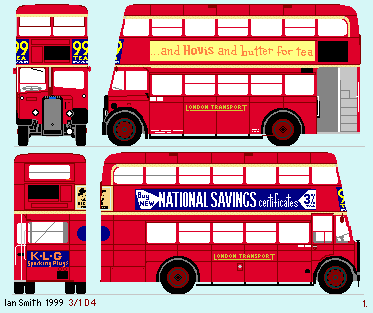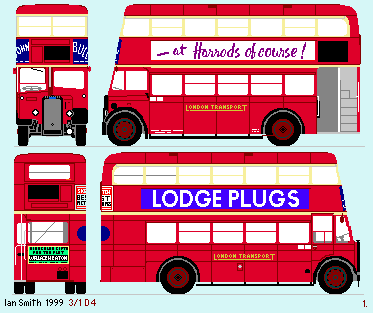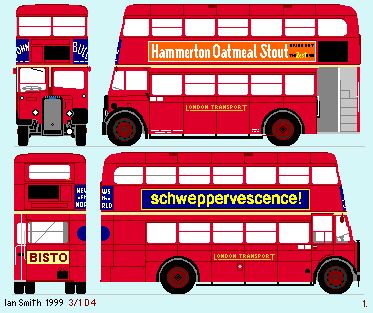
The LONDON TRANSPORT D classThis page created 27th December 1999, by Ian SmithPark Royal Daimlers: D182-D281In the immediate post-war period London Transport had an immediate need for vehicles. It was going to take time to re-establish RT production to take account of the lessons learned since the war-time production run ceased, and in the meantime they had a rag-bag collection of buses with which to maintain and build services. Every bus that they had was either already past retirement age or built using suspect wartime materials. The time-bomb was ticking, and would go off in 1948 as traffic burgeoned. Someone at London Transport took the wise decision to accept an allocation of another hundred Daimler CWA6 chassis (still controlled by the Ministry of Supply) and get them bodied. They approached Park Royal and Weymann, with a promise of RT production if they co-operated, but Weymann could not participate at this time. Park Royal said OK, but stipulated that the bodies would have to be of composite construction, using the currently available timber (unseasoned). Knowing that this put a short lifetime on the buses, someone at LT did the sums and said go.
Into serviceThe new buses were too tall for Merton garage. They could get in the back door to the maintenance facilities, but not in the front door. So Merton continued with its mixed allocation of Daimlers and STLs, while nearby Sutton garage (A) took the Park Royal Daimlers. Sutton had a daily run-out of 92 buses, so the 100 new Daimlers formed a complete allocation, initially at least. This allowed Sutton's STs and STLs to be reallocated to other parts of the LT system. From time to time the Sutton allocation varied, and a few other Daimlers, and some STs, were allocated to Sutton to make it all work.London Transport abandoned the 1946 livery even before the last of the Daimlers was delivered wearing it. The new version had cream surrounds to the upper deck windows, and this was the livery in vogue until 1950. This all the Sutton Daimlers adopted at their 1949 overhauls. The Daimlers operated on all of Sutton's double-decker routes:
Thus when the RTLs started to take over at Sutton in November 1953, on the 93, it was the unoverhauled buses with red and cream livery and high numbers that were the first to go. After-lifeOnce again, these seven year old buses found ready buyers on the second-hand market. The bodies were rather suspect, especially on the earlier sales, but the chassis had plenty of life in them. Belfast Corporation took many, rebodying them fairly quickly and then using them through to the end of the sixties. Many others found their way via North's in Leeds to independent operators, notably Ledgard's in the West Yorkshire conurbation, Trimdon Motor Services near Sedgefield, and Bee-Line at West Hartlepool. Southend Corporation bought a few (and was disappinted not to get more), and rebodied them for many years' further service. Yet others went to Ceylon.
The Sutton Daimlers may have had a short life with London Transport,
but they did the job they were bought to do, for the time period expected -
which is more than can be said of some of the Daimlers that came later to London Transport!
|
 The chassis were all AEC engined, and similar to all the other D class buses.
The bodies, by Park Royal, were exceptionally tall,
and even on the low-slung Daimler chassis
reached up to a full 14ft 6in.
They were to the relaxed utility outline, still with single-skinned bodies
with external roof framing, but with rounded domes.
The chassis were all AEC engined, and similar to all the other D class buses.
The bodies, by Park Royal, were exceptionally tall,
and even on the low-slung Daimler chassis
reached up to a full 14ft 6in.
They were to the relaxed utility outline, still with single-skinned bodies
with external roof framing, but with rounded domes.

 The Sutton Daimlers continued their south suburban existence into the 1950s,
while RTs and RTLs took over elsewhere.
A second overhaul round was started in late 1951,
and introduced the all red with single cream band livery.
This was applied to just over half the Sutton Daimlers before the decision
to halt the overhaul programme, in November 1952.
The Sutton Daimlers continued their south suburban existence into the 1950s,
while RTs and RTLs took over elsewhere.
A second overhaul round was started in late 1951,
and introduced the all red with single cream band livery.
This was applied to just over half the Sutton Daimlers before the decision
to halt the overhaul programme, in November 1952.
 bus histories
bus histories Ian's Bus Stop
Ian's Bus Stop Daimler index
Daimler index relaxed Duple
relaxed Duple